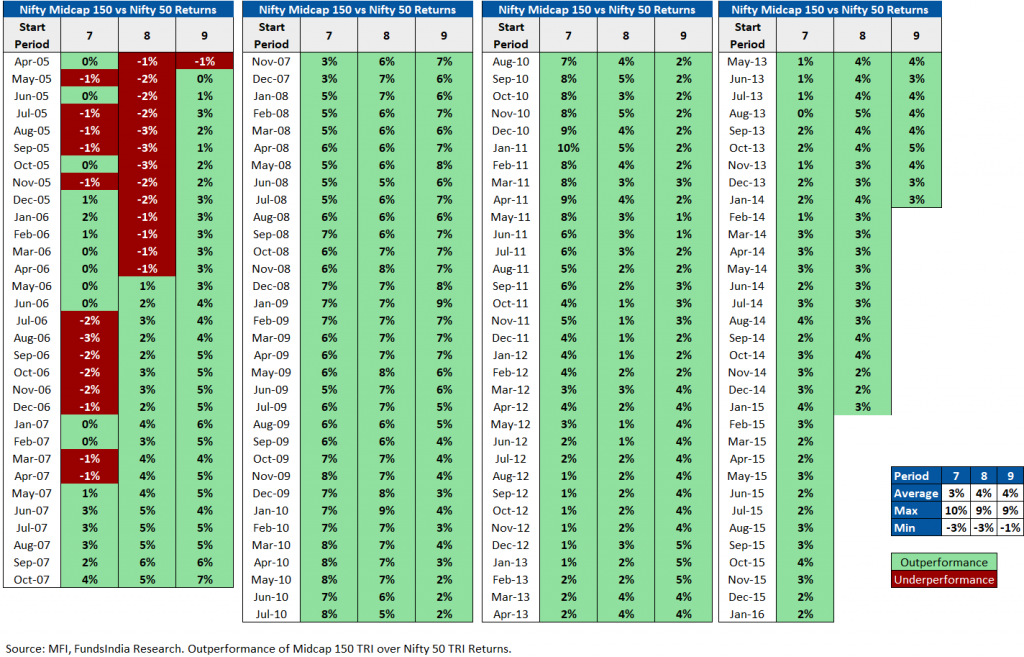This article was originally published in The Times of India. Click here to read it.
Do you want to know a simple trick which will help you improve long term returns from your Equity SIP portfolio?
Here is the trick – Include Midcap Equity Funds in your Equity SIP portfolio!
By including midcap equity funds in your equity SIP portfolio you stand a chance to earn better long term returns.
But how?
Let’s first start with the long term evidence.
The last 15+ years in a nutshell…
In the last 15+ years, a Midcap SIP (Nifty Midcap 150 TRI) has on an average outperformed large cap SIP (Nifty 50 TRI) by 3% over 7 year time frames!!
The table below shows the outperformance of Nifty Midcap 150 TRI over Nifty 50 TRI from different starting months across 7Y, 8Y and 9Y time frames. As seen below, majority of the times a midcap SIP has outperformed which is evident from the overwhelming green shades in the table.
The other way to verify this is to look at the rolling returns of a monthly SIP over a 10 year time frame and compare Nifty Midcap 150 TRI with Nifty 100 TRI.
Over a 10 year time frame if you were investing in Nifty Midcap TRI via a monthly SIP your average returns would have been 15%. A similar monthly SIP in Nifty 100 TRI would have on an average given returns of around 12%.
Also, the occurrences/chances of higher returns were in favor of Midcaps. 94% of the times the returns were more than 12% whereas for large caps only 59% of the times the returns were more than 12%.
What about periods where midcaps go through long phases of subdued or flat returns?
Midcap SIPs provided decent returns even during periods when lumpsums in midcaps didn’t do well.
In the chart below you can see the periods when the lump sum gave NIL returns but an SIP still gave reasonable returns (13% to 14% XIRR).
While the past evidence in terms of performance is convincing enough, but to be sure the same logic applies to the future as well, we need to answer another simple question
Why does this happen?
It’s simple. There are mainly two things that decide your long term SIP returns – 1) Number of mutual fund units accumulated and 2) Ending NAV (at the time of withdrawal).
The more the units you have at the end of your time frame and the higher the NAV at that time, then the better your SIP returns.
For instance, suppose you and your friend both start a monthly SIP of the same amount for a time frame of 7 years and start at an NAV of Rs.100. At the end of your time frame, assume you have accumulated 2000 units and the NAV is Rs 200. But, your friend has accumulated 2300 units and the NAV is Rs 220. The SIP return for your friend will be more than your SIP return because they have more units and a higher NAV. The additional units and higher NAV give an extra kicker to the SIP returns.
So, how do we get this combination for an extra kicker to SIP returns?
For any equity strategy to give you an extra kicker in SIP returns (vs large caps) it needs to tick these two criteria
- It should have higher volatility (read as higher temporary declines) vs largecaps over short periods of time. This is because for an SIP investor temporary market falls help accumulate more fund units at lower prices and when the market recovers the extra units accumulated also participate in the upside, thereby enhancing overall returns.
- It should have high odds of long term lumpsum outperformance vs large caps over a 7-10 year basis.
Criteria 1 takes care of the higher units part and Criteria 2 takes care of the higher NAV part!
Now let’s check if Midcaps satisfy these two criterias
Check 1: Are midcaps more volatile than largecaps?
To check for volatility we looked at the intra-year drawdown and compared Nifty Midcap 150 TRI with Nifty 50 TRI (which is a large cap index). We can see in the chart below that historically Midcap has had higher volatility (read as temporary declines) over short periods of time compared to large cap.
Check 2: Do midcaps outperform largecaps over the long term?
To check for this we compared the outperformance of Nifty Midcap 150 TRI versus Nifty 50 TRI. We can see in the table below that over a 7 to 10 year time frame, lumpsum investment in Midcap has outperformed Largecap with average outperformance of 3%.
Also, over a 10 year time frame, 100% of the time Midcaps have outperformed Largecaps.
As seen above, midcaps satisfy both the criterias which makes it a suitable candidate for improving your long term Equity SIP Performance.
So, what should you do?
Maintain at least 20-30% exposure to midcaps in your Equity SIP Portfolio.
If required, you can also increase the midcap allocation further depending on your time frame (longer the better) and ability to put up with larger temporary declines.
Summing it up
- Midcap SIPs have high odds of outperforming Large caps over long periods of time. Even during flat market phases Midcap SIPs have delivered decent returns.
- Midcaps give an extra kicker to long term Equity SIP portfolio returns driven by
- Higher volatility compared to large caps over short periods of time
- Higher odds of lumpsum outperformance over large caps in 7-10 year periods
- So, have at least 20-30% exposure to midcaps in your Equity SIP portfolio















Excellent Analysis and truly Insightful..
Keep it Up!!